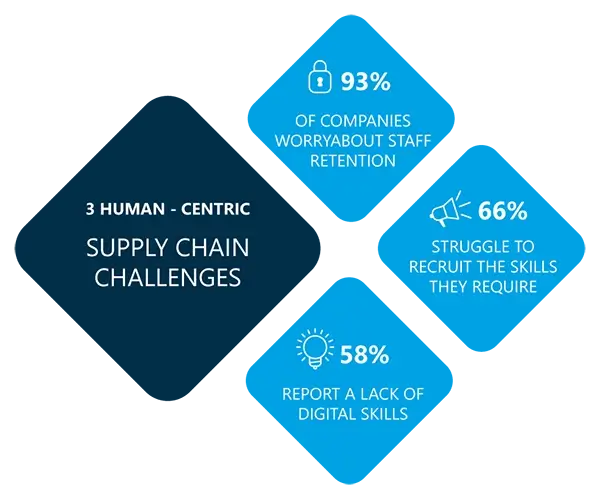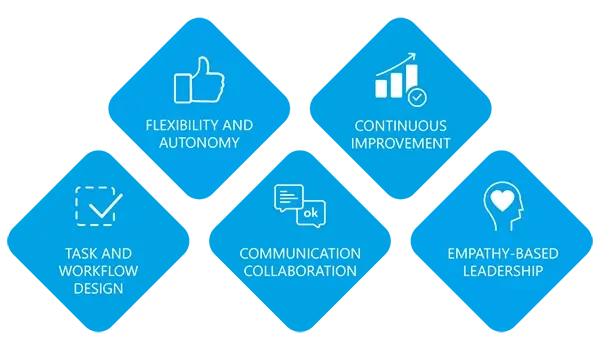Table of contents
Table of contents- Human-Centric Supply Chain – Power to Your People
- Why the future of your supply chain is human-centric
- How do you empower your people through human-centric work design?
- What is human-centric work design?
- The 5 Key Principles of human-centric work design in your supply chain
- How can a human-centric work design bring value to your business?
- How can Slimstock help you reap the rewards of a human-centric work design?
- Power to your people
- Human centric supply chain FAQs
Why the future of your supply chain is human-centric
Listen to the press, social media or the hushed whispers in the dark corridors of businesses across the world and you’ll be left with no doubt. AI is taking over the world.
You can use ChatGPT for holiday restaurant recommendations, writing a white paper or learning how to code. AI technology already underpins many business processes. In areas such as operation and supply chain, AI-enabled tools are helping businesses to make ever faster and smarter decisions.
Yet, as powerful as AI is, it will never replace the intuition, insight and intelligence you can gain when you pair it with a knowledgeable human partner. Put simply, your people are still very much in the driving seat.
Whether you use ChatGPT, as an example, or AI in general, the strength of its use case is only as powerful as the input you give it to begin with. To get the best results, it needs guidance, careful coercion and, most importantly, a special human touch.
But here’s the problem
According to a recent study by LinkedIn, 93% of companies worry about staff retention.
Coincidentally, approximately 66% of large UK businesses said they struggle to recruit new people who have the skills they need.
Worryingly, a similar number (58%) of employees have reported a lack of digital skills, citing a lack of training from their superiors.
So, to summarise the challenge, most companies are worried about losing staff. The majority of them struggle to recruit new people with a greater skill set. And the staff they do have, who they’re worried about losing, feel underprepared to do their jobs.
And so in this age of AI, businesses face a very real human problem.
To swing the pendulum in your favour, you’ll need to adopt a way of working that puts people at the forefront. Manage that, and any AI you introduce will add to your strategic edge.
But how do you do that?
How do you empower your people through human-centric work design?
Whether it’s a hangover from ‘the great resignation’, an increased desire to work from home or simply a collective re-evaluation of career journeys, times have changed.
To survive and thrive, the way you manage and motivate the people that run your supply chain must change with them.
That change has to come from above. From you and your leadership team.
You need to create empowerment. You need to use technology to enhance that empowerment. And you need to take tangible steps to train your staff to be the best they can be. Because if you don’t, someone else will.
And in today’s article, our focus is on people. Specifically your people.
We’ll run through how to revolutionise your supply chain by adopting a human-centric work design. We’ll help define what this means for your supply chain and how it can transform your business. But most importantly, we will reveal how you can redefine the role your people play to achieve a competitive advantage that sets you apart.
What is human-centric work design?
Let’s start with the basics.
Human-centric work design simply means designing your business around the needs, strengths, weaknesses and wellbeing of the people in your company. On paper, this sounds simple.
But it might be more complicated than you envisage. It might mean you need to re-design your processes, systems and environments entirely.
Changing the way your entire business works is no mean feat.
Developing a human-centric work design, or a human-centric supply chain means valuing your people. It means looking at organisational psychology, human-computer interaction, ergonomics, and organisational behaviour.
It means realising the value your people bring to the table while acknowledging their worries. Aspirations, dreams and goals can’t be achieved if you leave them out of the process of designing your supply chain.
In the next section, we will delve into what areas you should focus on.
The 5 Key Principles of human-centric work design in your supply chain
1. Task and workflow design
Are the supply chain workflows you depend on good for you, or good for your people? How do you manage tasks and how do your people feel about that?
Cognitive load and efficiency can work against each other if you don’t analyse the process from a human perspective. Reducing complexity where it’s not needed could make a huge difference to the people you employ. And that will make a massive difference to the potential success of your company.
Do your people have the tools they need? Are they trained well? Do they feel alone in their fight to do their daily job? Is their role clarified well enough?
If not, this is your first step.
2. Flexibility and autonomy
People want flexibility these days. That doesn’t necessarily mean they’re working less, and in most cases, it means they’ll achieve more. They’ll be happier in their work and feel a greater sense of appreciation for you.
Giving your employees control over their work, flexibility in how they deliver results, autonomy in decision-making, and the chances for development and growth will pay off massively.
And if you’re not happy to do this, because of a lack of confidence in their ability, that falls on your shoulders to fix.
3. Communication and collaboration
Information is power. And the more power your people have to do their jobs, the better their performance will be.
Are you using logical approaches to collaboration? Is the tech you utilise the best it can be? Are there silos in place that increase friction among the team?
Promoting a culture of transparency and cooperation between people, teams and departments will foster positive working relationships across your entire business.
4. Continuous improvement
Giving someone in your business feedback once a quarter, positive or negative, isn’t giving them the best chance to improve their ability.
Just like looking at your systems, processes and technology once a year will not address problems that arise, so ongoing feedback, learning, and adaptation will create continuous improvement.
But if your business is as dynamic as most, your people need to understand how their day-to-day actions and decisions make a difference. Not in the future. But now.
This means supporting your people with tools and technology that provide clarity and allow them to challenge their way of working. This also allows them to seek support as and when required. That means providing the means to continuously monitor performance via an approach that works for you and them.
5. Empathy-based leadership
The role of chief supply chain officer has been redefined in recent times. But so too has the role of supply chain managers and team leaders.
Make no mistake; the people that lead your supply chain have a lot on their plate. But making decisions that consider the people within it is good for business. Identifying empathy as one of the key drivers in making those decisions will leave you in great stead for better employee performance and retention.
This is true whether it’s in your supply chain or in any other part of the company. Try to create supportive environments and give your people the support they need to thrive.
5 KEY PRINCIPLES FOR
HUMAN-CENTRIC WORK DESIGN IN YOUR SUPPLY CHAIN
How can a human-centric work design bring value to your business?
There are real-life examples of a human-centric work design wherever you look. And some businesses have been using this approach in their business and supply chain with incredible results.
IKEA is a great example of that. By using a human-centric approach, IKEA has tripled their ecommerce in just three years. Highlighting how the business achieved this, Barbara Martin Coppola, Chief Design Officer at Ikea states:#
“How to embed ethical behaviour, respect diversity, how to treat people fairly — without bias — through technology. This means that we are focusing more on what we should do with data, rather than what we could do with data.”
It’s always easy to look at ideas and see the possible results as hypothetical. But IKEA has had very real results from taking the notion of human-centric processes on board. And so could you.
Here are some examples of the value-creation a human-centric approach throughout your supply chain could create for you and your business:
1. Enhanced supply chain performance
The best supply chains are built on efficiency. Don’t underestimate the power your people have on that journey. If you can increase communication in your team, and attain better collaboration as a result, your processes will be streamlined and your supply chain more capable as a result.
2. Increased agility and adaptability
Agility is one of the most important attributes of successful businesses. If the last few years haven’t helped you realise that, you’ve been incredibly lucky.
A human-centric work design will create a more agile and adaptable supply chain. If the people in your team feel valued, their confidence will soar. The higher their confidence, the better the decisions they’ll make as a result, and the more your supply chain will be optimised for changes in the market that currently feel outside your control.
3. Improved customer satisfaction
Have you ever dealt with a business where staff are unhappy? It doesn’t matter whether it’s a pub, bakery or supply chain organisation. The dissatisfaction seeps through into your consciousness.
But a human-centric work design focuses on the needs of the customer as much as the people you employ. You’ll create accountability, higher accuracy, and increased reliability to deliver what your customer wants and ultimately make them happier.
4. Cost optimisation and efficiency
Firefighting will only take your business so far. The more your processes are streamlined, the better you leverage technology and manage the collective workload, the reduced costs you’ll see from inefficiency. More importantly, you will open doors to reduced waste, improved productivity and therefore improve the profitability of your business.
5. Talent retention and attraction
As we mentioned at the start of this article, the best businesses tend to hold on to their people. And that’s not a coincidence. They’re happier, challenged, and supported and have far greater wellbeing than those with high attrition rates.
Great morale, teamwork, and engagement can create a more productive and harmonious work environment. A human-centric supply chain will improve the metrics on all of these.#
How can Slimstock help you reap the rewards of a human-centric work design?
At Slimstock, we have been helping our clients create sustainable supply chains for over 30 years.
We’ve done this by empowering planning teams to make better supply chain decisions. That starts, continues and ends with the people within those supply chains.
We help businesses eliminate waste at every step. That constitutes time, resources, and most importantly, talent. Your people are the glue which holds your supply chain together. And without a well-performing, efficient supply chain, your business will fail.
This is why we’ve developed our award-winning optimisation platform, Slim4, to make supply chain planning easy for everyone. For you and your people.
A formula for success
Here are a few examples of how the combination of our Slim4 platform and our committed team can underpin the people and processes throughout your supply chains to help you achieve supply chain excellence:
1. Slim4 offers a user experience teams love
It’s no good spending time and money on new technology if your people don’t love using it. That’s why we’ve put so much effort into creating a product that works for you and your team.
And to ensure that the people who ultimately use Slim4 enjoy the best possible experience as our platform continues to advance, our development process is underpinned by 7 key design principles:
- Deliver dependable outcomes for you and your team.
- Support you with robust insights so you can achieve your goals faster.
- Streamline your workload so you can complete tasks quickly and easily.
- Fit around your personal way of working.
- Create security and control to put your mind at ease.
- Enable effective decision-making by providing you with the information you need.
- Keep you informed with direct and clear feedback.
2. Our platform is built to put your team in the driving seat
Slim4 offers flexible views, to-do lists and dashboards, all wrapped up in a tool you’ll love.
You can take control of diversified suppliers, volatile lead times and spiralling assortments to remain agile. That will help you eliminate firefighting with responsive, exception-based alerts to help your team stay focused on what matters most.
You can seamlessly integrate critical business processes including demand planning, inventory optimisation, portfolio management and supply planning to attain greater control over your entire supply chain.
Want to connect your people and processes? Our AI-powered planning tool creates collaboration throughout your supply chain.
By capturing insight from across the entire business, Slim4 helps your people make better supply chain decisions. Better decisions for you, and better decisions for your team.
3. Our training elevates your team’s knowledge
With better knowledge comes better decisions and a vastly improved supply chain.
That’s why we developed the Slimstock Academy and why it’s so popular with our clients.
Each year we give thousands of supply chain professionals actionable inventory insights, ongoing developments and the proven techniques they need to realise their goals.
We offer a range of training programmes, knowledge sessions and community events.
Our academy courses are designed to help you and your people translate business strategy into effective supply chain actions.
We’re committed to sharing industry knowledge and best practices via our dedicated academy and community networks. That’s why, after 30+ years in business, Slimstock is a trusted knowledge partner for thousands of supply chain professionals around the world.
Power to your people
If you weren’t aware of the power you can have in your industry by empowering your people, I hope this article’s impressed how necessary it is for modern business.
It’s not enough to simply take on the power of AI, technology and machine learning at the cost of what makes you special. Because for as long as there are businesses, the people within those businesses will hold the key to success.
The better your people are, the better you’ll be. And today, you need every single competitive advantage you can muster to give you the edge.
But the best part of this is, you almost certainly have that edge already.
A human-centric work design is absolutely crucial for the success of your supply chain in 2023 and beyond.
It can create value for your entire business and improve employee satisfaction, elongate tenure and provide far happier customers.
And if you need help in instilling this process beyond this article, we’ve meticulously developed the technology to help you in Slim4.
That, and our expert team can help you reap the rewards of human-centric work design and dominate the market for years to come.
Human centric supply chain FAQs
What is human-centric work design in the context of supply chains?
Human-centric work design in the context of supply chains means designing business processes and systems around the needs, strengths, and well-being of the people involved. It prioritises valuing employees, promoting collaboration, and empowering them with flexibility and autonomy to optimize supply chain performance and achieve business success.
How does human-centric work design benefit supply chain performance?
Empowering employees with flexibility, autonomy, and continuous improvement opportunities results in higher motivation and creativity, ultimately enhancing the agility and adaptability of the supply chain to meet market demands effectively.
How can a human-centric work design improve supply chain agility and adaptability?
A human-centric work design can improve supply chain agility and adaptability by empowering employees to take ownership of their work, make decisions, and collaborate effectively.







